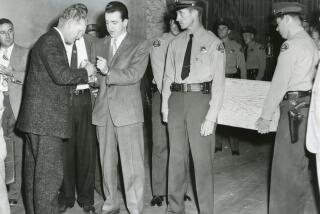Wyoming mock retrial stirs up gallows rumor : Was assassin Tom Horn hanged unjustly in 1903? Then who railroaded him? Who shot the kid?
- Share via
CHEYENNE, Wyo. — When they hanged Tom Horn here 90 years ago, there weren’t too many tears. After all, he was the most notorious assassin and range detective in the employ of the Wyoming cattle barons. After being convicted of ambushing and killing a 14-year-old boy who was part of a sheep-herding family, he was led to the gallows in January, 1903.
But now Horn is getting a second chance: A group of Horn aficionados say they believe that a recent mock retrial of the murder case shows that their man was wrongly convicted.
In the crime in question, Willie Nickell was shot twice through the chest and left on a road in the Iron Mountain country of southeast Wyoming in July, 1901.
The murdered boy’s head rested on a flat rock, and legend has it that was Horn’s message to his employers that he had committed the crime, so they would know he should be paid for it.
For years, many students of the case argued that Horn was railroaded. Their suspicions were directed primarily at the Millers, a nearby family with whom the Nickells had carried on a feud for many years.
The Tom Horn Kick and Growl--a group of Horn buffs who have gathered for the last six years in Cheyenne to debate the legend (and maybe to party a little)--decided to stage a retrial last month.
Michigan product-liability attorney Joseph Moch took up Horn’s defense, saying “it’s a chance to rewrite history, to see what should have been done.”
The original defense team, he added, “was outrageously ill-prepared.”
In the retrial, however, it was the prosecution that came up short when it came to preparation time. The Denver attorneys who had originally agreed to represent the state backed out at the last minute, so Moch’s assistant for the mock case, Wyoming lawyer Robert Skar, stepped in as prosecutor.
Cheyenne had been in an uproar over the first trial in 1902. More than a hundred witnesses were subpoenaed, and the courtroom was filled every day. The courtroom was again standing-room-only for the retrial.
Local people who had studied the transcripts of the original trial took the parts of the witnesses. Spectators and participants dressed in period costumes, one even walking to the stand with silver spurs clattering at each step.
Ken Rolfness, who won a Tom Horn look-alike contest in 1990, portrayed the defendant.
Retired Wyoming Supreme Court Justice C. Stuart Brown presided over the trial. The most damning evidence at the original trial--presented again at the retrial--was a confession that Horn made to Deputy Marshal Joe LeFors in 1902. LeFors is best known as the tracker who led a posse in pursuit of Butch Cassidy and the Sundance Kid.
Lefors lured Horn to his office with a promise of a job as a range detective--Horn’s nominal line of work--in Montana. LeFors asked Horn: “How far was Willie Nickell killed?” And Horn answered: “About 300 yards. It was the best shot I ever made, and the dirtiest trick I ever done.”
And at the end of the confession, Horn said: “Killing is my specialty. I look at it as a business proposition, and I think I have a corner on the market.” That was not an idle boast. Horn almost certainly killed several other men, some of whom may or may not have been rustlers.
But in the retrial, Moch cast considerable suspicion on Jim Miller and his son, Victor, who had feuded with the Nickells for years, leading to several fights, whippings and stabbings.
The 18-person jury returned a not-guilty verdict. Wyoming Gov. Mike Sullivan declined to pardon Horn posthumously, but the Horn Kick and Growl nevertheless seemed pleased to have added a postscript to history.
“Justice is timeless,” Moch said.
Guilty or innocent, Horn’s execution marked the end of the rule of the cattle barons in the Rockies. Throughout his incarceration while awaiting hanging, Horn never revealed the names of his employers, believing their influence would be strong enough to save him.
Chip Carlson, who wrote a book about Horn and who was the inspiration behind the retrial, noted that the cattle barons often acted in a high-handed manner.
Once, informed by a range detective of the activities of some rustlers, the secretary of the Wyoming Stockgrowers Assn. sent this message: “I can understand how serious the problem is. Kill them first, and then arrest them.”
More to Read
Sign up for Essential California
The most important California stories and recommendations in your inbox every morning.
You may occasionally receive promotional content from the Los Angeles Times.













